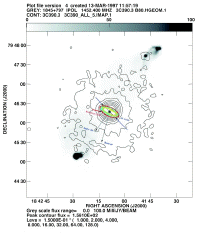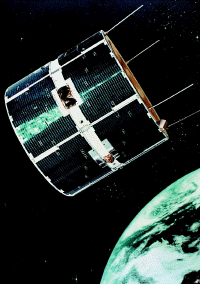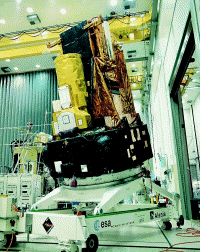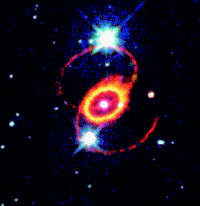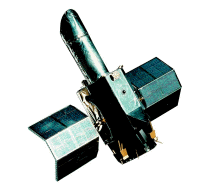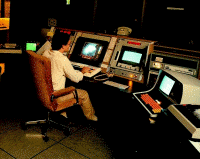IUE: storm signals
The size of a black hole's dinner-plate
To explain eruptions seen in galaxies, theorists blamed giant black holes. Observations tallied with, but did not prove, the idea that a black hole eats gas from a flat, incandescent dinner-plate surrounding it, called an accretion disk. In 1997 a team led by Willem Wamsteker of ESA's Space Science Department made conjecture a reality. They announced that the accretion disk in Galaxy 3C390.3 was one-fifth of a light-year across, and 1 500 times wider than the black hole at its centre.
Figure 4. Accretion disk in Galaxy 3C390.3. Diagram (not to scale) on X-ray and radio images from Harris et al. (ApJ. 499, L149) and 1452 Mhx VLA
IUE examined Galaxy 3C390.3 thirty-nine times over fourteen years. The scientists also consulted observations by five X-ray satellites. Whenever the black hole consumed a larger morsel than usual, the galaxy flared up, but light took more than a month to reach the edge of the accretion disk. This delay measured the disk's width. From motions of gas, the scientists calculated the fate of an unlucky star captured by the black hole. Shredded by the intense gravity, its gas would swirl twice around the black hole before disappearing into its maw after 150 years.
"Results like this show that IUE's data will continue to give new astronomy for decades to come," Willem Wamsteker commented. "Future generations of astronomers will look back through our eighteen years of unique observations with questions that we haven't even thought of yet."
Golden age of high-energy astronomy
With its COS-B satellite launched in 1975 ESA pioneered gamma-ray astronomy and put European astronomers at the forefront of the field. Gamma-rays are even more energetic than X-rays. Exploding stars, black holes and other strange objects are among the sources of this powerful radiation.
COS-B was followed by the Russian-French mission GRANAT and NASA's Compton Gamma Ray Observatory, both of which involved some of the COS-B teams. ESA now has INTEGRAL, the INTErnational Gamma-Ray-Astrophysics Laboratory, which will use advanced detectors unavailable to the COS-B pioneers. Launch by a Russian Proton rocket from Baikonur is scheduled for 2001.
|
| |
|
Brian Taylor | |
|
|
"With its enormous gain in sensitivity, spectral and image quality over its forebears, INTEGRAL will revolutionise the field in probing to the heart of the most violent events occurring in the cosmos", said Brian Taylor, head of ESA's Astrophysics Division at Noordwijk in the Netherlands. "INTEGRAL together with the X-ray astronomy satellite XMM promises a golden age for high-energy astrophysics at the start of the new millennium."
Last updated: 24 March 2000
Identified: the great exploding star of 1987
The event of the century for astronomers was the cataclysmic explosion of a massive star. Although such supernovae are crucial in cosmic history, and the source of the Earth's gold and uranium, none had been seen at close range with modern instruments. Stargazers spotted Supernova 1987A in February 1987, in the Large Magellanic Cloud in the southern sky. When the news broke, the very first space telescope to turn towards Supernova 1987A was the astronomical satellite IUE.
As the supernova faded rapidly in the ultraviolet, IUE's experts could say, years before other observers, exactly which star blew up. It was a blue star, not red as expected. The satellite registered ultraviolet signatures of newly-made chemical elements released by the explosion.
The flash lit up a distant ring of gas surrounding the star, and IUE recorded an echo of the light, a month after the explosion. In 1990 the Hubble Space Telescope began examining the scene. The European Space Agency's Faint Object Camera on Hubble detected a cloud of debris and measured its expansion rate. It also imaged the ring of gas responsible for IUE's echo from the supernova. Later, NASA's wide-field cameras examined the ring, which is shown coloured yellow in the accompanying image.
Figure 1. HST (NASA & ESA) WPC2, processed by S. Scuderi
"From IUE's light echo and the ring measured with Hubble, we could tell how far away the supernova was," said Nino Panagia, an ESA scientist from Italy working at the Space Telescope Science Institute. "In 1991 we put Supernova 1987A at a distance of 167 000 light-years. With better pictures we confirmed that result, and reduced the uncertainty to as little as two percent."
IUE, or International Ultraviolet Explorer, was a NASA-ESA-UK venture. It analysed ultraviolet light from the stars. This is blocked by the Earth's ozone layer but often carries storm signals of cosmic upheavals. Launched in 1978, IUE operated until 1996, making it the longest-lived astronomical spacecraft ever.
Figure 3. IUE operations at Villafranca, Spain
At Villafranca, Spain, guest observers were able to oversee IUE's science operations at ESA's ground station. The user-friendly spirit survives in interactive archives at Villafranca. They give astronomers easy access to re-processed results from 104 000 ultraviolet observations, ranging from auroras on Jupiter to eruptions in distant galaxies and quasars.
|
| |
|
Ana Ines Gomez | |
|
|
"It was a wonderful way to do space astronomy," said Ana Ines Gomez de Castro, a Spanish expert on young stars. "To be in the IUE room at Villafranca was like working in the control room of a ground-based telescope but with the ultraviolet Universe in plain view."

